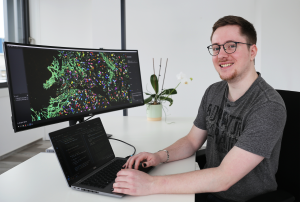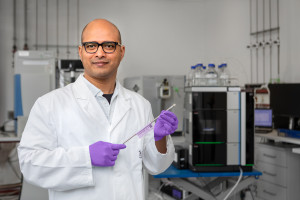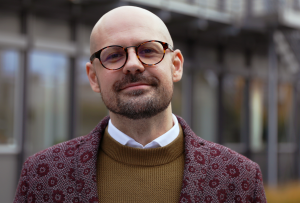Dortmund, 17th January 2025

In addition to his role as a software engineer, Lennart Kowitz is also a member of the works council at ISAS.
Lennart Kowitz joined ISAS in 2017 as an IT specialist-trainee. Today, he works here as a software engineer in the AMBIOM – Analysis of Microscopic BIOMedical Images research group and is involved in the works council. The 27-year-old is also studying computer science at TU Dortmund University. To find out more about his work in the ISAS research group, the editorial team asked him to complete the following sentences.
-
At ISAS I work…
on making AI methods accessible to biomedical researchers. In other words, I make sure that they can use the AMBIOM tools without extensive programming knowledge. Moreover, I take care of cluster management in our research group. A cluster is a group of computers that are particularly suited for calculations. My IT experience also allows me to act as an interface between our team and the IT department at ISAS.
-
After my IT training, I stayed at the institute because...
I wanted to maintain my work rhythm at first. During my training, I learnt to structure my (working) day. After completing my IT training, I initially worked in administration at ISAS. As I had previously felt very comfortable in IT, I toyed with the idea of returning there later. In the end, however, things turned out differently: ISAS set up an AI research group for analysing biomedical microscope images, for which I then applied internally.
-
What particularly fascinates me about my work...
is the interplay of expertise: We have the skills of our AI experts on the one hand and our end users from biomedical research on the other. For me, software development is the most abstract thing there is. It is hard to visualise software itself, it is not tangible. That makes it very fascinating to deal with and to find out how I can develop good software for the scientists in the lab. This is a journey I have been on for three and a half years. And fortunately, with so many approaches, ideas and concepts in circulation at AMBIOM, it is not going to end any time soon.
-
I am involved in the works council because...
I think it is important to represent the interests of all employees. I also have the opportunity to learn a lot at training courses, for example on labour law, which I can use to support my colleagues. I also really appreciate the dialogue with the works councils from other Leibniz Institutes.








